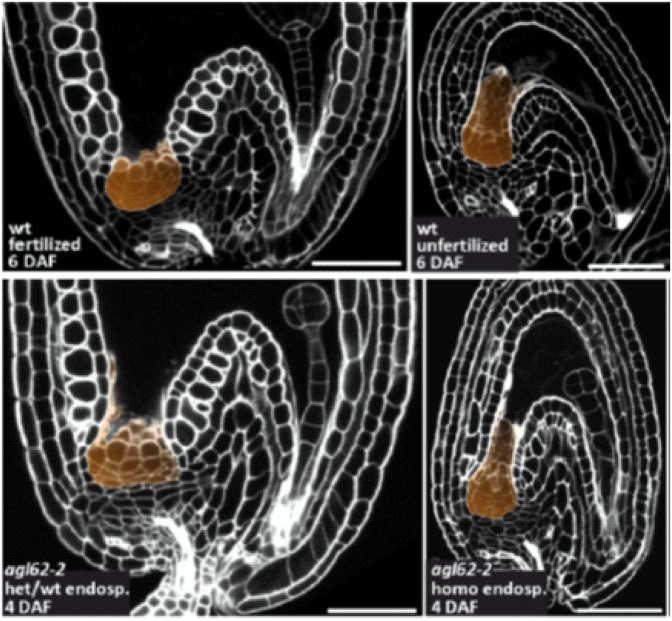Seed production in angiosperms relies on the coordinated development of three genetically distinct tissues: the embryo that is formed following fertilization of the egg cell of the female gametophyte, the endosperm that develops from the simultaneous fertilization of its central cell, and the surrounding maternal tissue, including the nucellus, that encloses the developing embryo. Although this maternal tissue is not directly involved in the fertilization process, its development and composition are distinctly altered following fertilization. Different plant species follow different nutrient-storing strategies by favoring development of either the embryo (most legumes), the endosperm (cereals), or the perisperm (pseudocereals such as quinoa and amaranth), which originates from the nucellus (Sreenivasulu and Wobus, 2013). In Arabidopsis thaliana, one particular cell in the nucellus, the megaspore mother cell, undergoes meiosis to form the female gametophyte, which then develops at the expense of the nucellus, which degenerates following fertilization.
The regulatory network mediating the development of the nucellus following fertilization is largely unknown. Xu et al. (2016) use a modified pseudo-Schiff propidium iodide technique (Truernit et al. 2008) to create three-dimensional reconstructions of Arabidopsis seeds to study nucellus versus endosperm development in detail. They first show that nucellus degeneration is dependent on fertilization, as fertilized ovules had lost about half of the nucellus cells 6 d after flowering (see figure, top left). By contrast, the number of nucellus cells in unfertilized ovules had increased slightly (see figure, top right). Using the Arabidopsis kokopelli mutant, in which sporadic single fertilization events randomly produce seeds with either embryo or endosperm, the authors demonstrate that fertilization of the central cell is necessary and sufficient to stimulate nucellus degeneration.
Fertilization and AGL62 are required for nucellus degeneration. In wild-type Arabidopsis ovules, the nucellus (orange) degenerates following fertilization (top left) but remains intact in unfertilized ovules (top right). Seeds with heterozygous agl62 or wild-type endosperm are normal (bottom left), but in seeds with homozygous agl62 endosperm, the nucellus does not degenerate (bottom right). DAF, days after flowering. (Reprinted from Xu et al. [2016], Figure 2.)
Using a combination of visual inspection and RNA in situ hybridization assays, they provide evidence that nucellus degeneration in unfertilized ovules is repressed by two Polycomb-group proteins, preventing fertilization-independent seed formation. Fertilization results in activation of AGAMOUS-LIKE62 (AGL62), a MADS box transcription factor (Kang et al., 2008) that initiates the signal relieving this repression, thus stimulating nucellus degeneration.
Because homozygous agl62 seeds are seed-lethal, the authors studied nucellus degeneration in seeds from agl62/wt heterozygote plants. These plants produce both normal and nonviable seeds, and it is the genotype of the endosperm that determines seed viability. Seeds with heterozygous agl62 or wild-type endosperm develop normally like wild-type seeds (see figure, bottom left), but seeds with homozygous agl62/agl62/agl62 endosperm do not develop and the nucellus does not degenerate (see figure, bottom right). These data demonstrate a crucial role of AGL62 in signaling nucellus degeneration.
To characterize the regulatory network downstream of the Polycomb proteins, the authors conducted a comprehensive study of the role of TRANSPARENT TESTA16 (TT16), a transcription factor required for proper differentiation of the seed coat. Through a combination of genetic, biochemical, and histochemical analyses, they show that TT16 is expressed in the nucellus, promotes nucellus degeneration following fertilization, and is epistatic to FERTILIZATION INDEPENDENT ENDOSPERM, one of the Polycomb proteins. They then characterize other downstream components of this regulatory system and study the role of programmed cell death in nucellus degeneration. Finally, the authors summarize their results in a detailed model of the regulatory network, which shows the proposed roles of the various proteins in the crosstalk that regulates relative nucellus and endosperm development.
Supplementary Material
Footnotes
Articles can be viewed without a subscription.
References
- Kang I.H., Steffen J.G., Portereiko M.F., Lloyd A., Drews G.N. (2008). The AGL62 MADS domain protein regulates cellularization during endosperm development in Arabidopsis. Plant Cell 20: 635–647. [DOI] [PMC free article] [PubMed] [Google Scholar]
- Sreenivasulu N., Wobus U. (2013). Seed-development programs: a systems biology-based comparison between dicots and monocots. Annu. Rev. Plant Biol. 64: 189–217. [DOI] [PubMed] [Google Scholar]
- Truernit E., Bauby H., Dubreucq B., Grandjean O., Runions J., Barthélémy J., Palauqui J.C. (2008). High-resolution whole-mount imaging of three-dimensional tissue organization and gene expression enables the study of Phloem development and structure in Arabidopsis. Plant Cell 20: 1494–1503. [DOI] [PMC free article] [PubMed] [Google Scholar]
- Xu W., Fiume E., Coen O., Pechoux C., Lepiniec L., Magnani E. (2016). Endosperm and nucellus develop antagonistically in Arabidopsis seeds. Plant Cell 28: 1343–1360. [DOI] [PMC free article] [PubMed] [Google Scholar]
Associated Data
This section collects any data citations, data availability statements, or supplementary materials included in this article.



